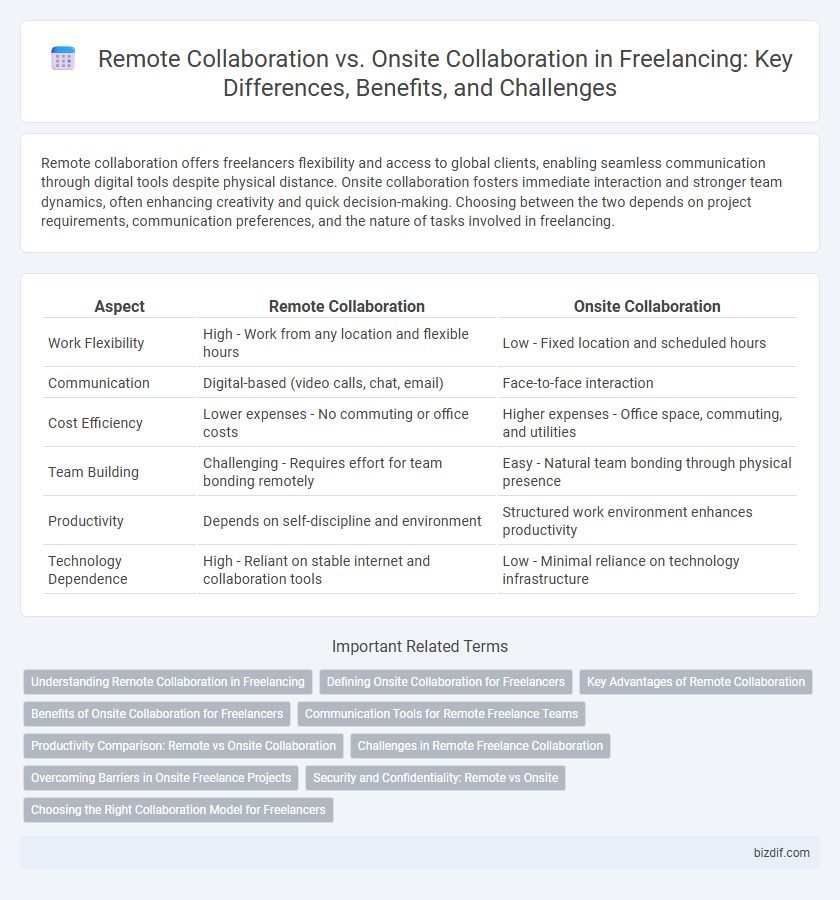Remote collaboration offers freelancers flexibility and access to global clients, enabling seamless communication through digital tools despite physical distance. Onsite collaboration fosters immediate interaction and stronger team dynamics, often enhancing creativity and quick decision-making. Choosing between the two depends on project requirements, communication preferences, and the nature of tasks involved in freelancing.
Table of Comparison
| Aspect | Remote Collaboration | Onsite Collaboration |
|---|---|---|
| Work Flexibility | High - Work from any location and flexible hours | Low - Fixed location and scheduled hours |
| Communication | Digital-based (video calls, chat, email) | Face-to-face interaction |
| Cost Efficiency | Lower expenses - No commuting or office costs | Higher expenses - Office space, commuting, and utilities |
| Team Building | Challenging - Requires effort for team bonding remotely | Easy - Natural team bonding through physical presence |
| Productivity | Depends on self-discipline and environment | Structured work environment enhances productivity |
| Technology Dependence | High - Reliant on stable internet and collaboration tools | Low - Minimal reliance on technology infrastructure |
Understanding Remote Collaboration in Freelancing
Remote collaboration in freelancing leverages digital tools such as project management software, video conferencing, and cloud storage to enable seamless communication and efficient task management across different locations. Freelancers benefit from flexible schedules and access to global clients while overcoming challenges like time zone differences and limited face-to-face interaction. Mastery of remote collaboration platforms enhances productivity, fosters accountability, and supports the building of trust in virtual work environments.
Defining Onsite Collaboration for Freelancers
Onsite collaboration for freelancers involves working physically at a client's location or shared office space, fostering direct communication and immediate feedback. This approach enhances team cohesion, enables real-time problem-solving, and allows freelancers to integrate more deeply with the company culture. Onsite collaboration often leads to increased trust and streamlined project management through face-to-face interactions and spontaneous brainstorming sessions.
Key Advantages of Remote Collaboration
Remote collaboration offers increased flexibility and access to a global talent pool, enabling teams to work across multiple time zones and diverse skill sets. It reduces overhead costs by eliminating commuting and office space expenses while fostering a better work-life balance for freelancers. Advanced digital tools like video conferencing, cloud storage, and project management software enhance communication and productivity in remote work environments.
Benefits of Onsite Collaboration for Freelancers
Onsite collaboration enhances real-time communication and fosters stronger team cohesion, which is crucial for freelancers working on complex projects. Face-to-face interactions reduce misunderstandings and enable immediate feedback, increasing efficiency and project accuracy. Access to onsite resources and spontaneous brainstorming sessions also accelerate problem-solving and innovation.
Communication Tools for Remote Freelance Teams
Effective communication tools like Slack, Zoom, and Microsoft Teams enhance remote freelance teams' collaboration by facilitating real-time messaging, video conferencing, and file sharing, which bridge the gap created by physical distance. These platforms support asynchronous communication and integrate with project management software such as Trello and Asana, promoting productivity and task tracking across different time zones. Leveraging cloud-based tools also ensures that remote freelancers maintain synchronization, transparency, and efficient workflow comparable to onsite collaboration environments.
Productivity Comparison: Remote vs Onsite Collaboration
Remote collaboration enhances productivity by leveraging digital tools that enable seamless communication and task management across different time zones, reducing downtime and increasing flexibility. Onsite collaboration fosters immediate feedback and spontaneous problem-solving through face-to-face interactions, often accelerating decision-making processes. Studies show that hybrid models combining both remote and onsite elements yield up to 25% higher productivity by balancing flexibility with direct engagement.
Challenges in Remote Freelance Collaboration
Remote freelance collaboration often faces challenges such as time zone differences, leading to delays in communication and project delivery. Limited face-to-face interaction can cause misunderstandings and hinder building strong client relationships. Technical issues and reliance on digital tools may disrupt workflow and reduce overall productivity in remote teams.
Overcoming Barriers in Onsite Freelance Projects
Overcoming barriers in onsite freelance projects requires clear communication strategies, including regular check-ins and the use of collaborative tools to align expectations and progress. Building strong interpersonal relationships through face-to-face interactions helps resolve misunderstandings quickly and fosters trust among team members. Utilizing project management software tailored for onsite workflows ensures transparency and accountability, minimizing delays and enhancing productivity.
Security and Confidentiality: Remote vs Onsite
Onsite collaboration offers enhanced security and confidentiality through controlled physical access to sensitive information and direct supervision, reducing risks of data breaches. Remote collaboration requires robust cybersecurity protocols, including encrypted communication and secure access controls, to protect confidential data from cyber threats. Ensuring compliance with data protection regulations such as GDPR and HIPAA is critical in both remote and onsite environments to safeguard client information effectively.
Choosing the Right Collaboration Model for Freelancers
Freelancers must evaluate project scope, communication preferences, and client requirements when choosing between remote collaboration and onsite collaboration models. Remote collaboration offers flexibility and access to global clients, while onsite collaboration fosters real-time interaction and stronger team cohesion. Selecting the ideal model enhances productivity and aligns with the freelancer's workflow and professional goals.
Remote Collaboration vs Onsite Collaboration Infographic

 bizdif.com
bizdif.com